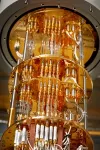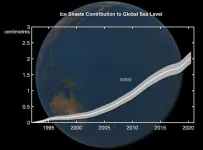(Press-News.org) There are high expectations that quantum computers may deliver revolutionary new possibilities for simulating chemical processes. This could have a major impact on everything from the development of new pharmaceuticals to new materials. Researchers at Chalmers University have now, for the first time in Sweden, used a quantum computer to undertake calculations within a real-life case in chemistry.
“Quantum computers could in theory be used to handle cases where electrons and atomic nuclei move in more complicated ways. If we can learn to utilise their full potential, we should be able to advance the boundaries of what is possible to calculate and understand,” says Martin Rahm, Associate Professor in Theoretical Chemistry at the Department of Chemistry and Chemical Engineering, who has led the study.
Within the field of quantum chemistry, the laws of quantum mechanics are used to understand which chemical reactions are possible, which structures and materials can be developed, and what characteristics they have. Such studies are normally undertaken with the help of super computers, built with conventional logical circuits. There is however a limit for which calculations conventional computers can handle. Because the laws of quantum mechanics describe the behaviour of nature on a subatomic level, many researchers believe that a quantum computer should be better equipped to perform molecular calculations than a conventional computer.
“Most things in this world are inherently chemical. For example, our energy carriers, within biology as well as in old or new cars, are made up of electrons and atomic nuclei arranged in different ways in molecules and materials. Some of the problems we solve in the field of quantum chemistry are to calculate which of these arrangements are more likely or advantageous, along with their characteristics,” says Martin Rahm.
A new method minimises errors in the quantum chemical calculations
There is still a way to go before quantum computers can achieve what the researchers are aiming for. This field of research is still young and the small model calculations that are run are complicated by noise from the quantum computer’s surroundings. However, Martin Rahm and his colleagues have now found a method that they see as an important step forward. The method is called Reference-State Error Mitigation (REM) and works by correcting for the errors that occur due to noise by utilising the calculations from both a quantum computer and a conventional computer.
“The study is a proof-of-concept that our method can improve the quality of quantum-chemical calculations. It is a useful tool that we will use to improve our calculations on quantum computers moving forward,” says Martin Rahm.
The principle behind the method is to first consider a reference state by describing and solving the same problem on both a conventional and a quantum computer. This reference state represents a simpler description of a molecule than the original problem intended to be solved by the quantum computer. A conventional computer can solve this simpler version of the problem quickly. By comparing the results from both computers, an exact estimate can be made for the amount of error caused by noise. The difference between the two computers’ solutions for the reference problem can then be used to correct the solution for the original, more complex, problem when it is run on the quantum processor. By combining this new method with data from Chalmers’ quantum computer Särimner* the researchers have succeeded in calculating the intrinsic energy of small example molecules such as hydrogen and lithium hydride. Equivalent calculations can be carried out more quickly on a conventional computer, but the new method represents an important development and is the first demonstration of a quantum chemical calculation on a quantum computer in Sweden.
“We see good possibilities for further development of the method to allow calculations of larger and more complex molecules, when the next generation of quantum computers are ready,” says Martin Rahm.
Quantum computer built at Chalmers
The research has been conducted in close collaboration with colleagues at the Department of Microtechnology and Nanoscience. They have built the quantum computers that are used in the study, and helped perform the sensitive measurements that are needed for the chemical calculations.
“It is only by using real quantum algorithms that we can understand how our hardware really works and how we can improve it. Chemical calculations are one of the first areas where we believe that quantum computers will be useful, so our collaboration with Martin Rahm’s group is especially valuable,” says Jonas Bylander, Associate Professor in Quantum Technology at the Department of Microtechnology and Nanoscience.
More about the research
Read the article Reference-State Error Mitigation: A Strategy for High Accuracy Quantum Computation of Chemistry in the Journal of Chemical Theory and Computation.
The article is written by Phalgun Lolur, Mårten Skogh, Werner Dobrautz, Christopher Warren, Janka Biznárová, Amr Osman, Giovanna Tancredi, Göran Wendin, Jonas Bylander, and Martin Rahm. The researchers are active at Chalmers University of Technology.
The research has been conducted in cooperation with the Wallenberg Centre for Quantum Technology (WACQT) and the EU-project OpensuperQ. OpensuperQ connects universities and companies in 10 European countries with the aim of building a quantum computer, and its extension will contribute further funding to researchers at Chalmers for their work with quantum chemical calculations.
*Särimner is the name of a quantum processor with five qubits, or quantum bits, built by Chalmers within the framework of the Wallenberg Center for Quantum Technology (WACQT). Its name is borrowed from Nordic mythology, in which the pig Särimner was butchered and eaten every day, only to be resurrected. Särimner has now been replaced by a larger computer with 25 qubits and the goal for WACQT is to build a quantum computer with 100 qubits that can solve problems far beyond the capacity of today’s best conventional super-computers.
For more information, please contact:
Martin Rahm, Associate Professor in Theoretical Chemistry at the Department of Chemistry and Chemical Engineering, Chalmers University of Technology martin.rahm@chalmers.se +46 31 772 30 50
END
Swedish quantum computer applied to chemistry for the first time
2023-04-20
ELSE PRESS RELEASES FROM THIS DATE:
Polar ice sheet melting records have toppled during the past decade
2023-04-20
The seven worst years for polar ice sheets melting and losing ice have occurred during the past decade, according to new research, with 2019 being the worst year on record.
The melting ice sheets now account for a quarter of all sea level rise – a fivefold increase since the 1990’s – according to IMBIE, an international team of researchers who have combined 50 satellite surveys of Antarctica and Greenland taken between 1992 and 2020.
Their findings are published today in the journal Earth System Science Data.
Global heating is melting ...
Companies’ zero-deforestation commitments have potential to halve cattle-driven deforestation in Brazilian Amazon
2023-04-20
Cattle-rearing is the biggest cause of tropical deforestation in the Amazon - and the world.
A study has found that some of the world’s largest slaughterhouses reduced cattle-driven deforestation in the Amazon by 15% - equivalent to sparing 7,000km2 of forest from clearance (4.5 times the size of London) - through their commitment to zero-deforestation policies between 2010 and 2018.
If these policies were fully implemented and adopted across all cattle companies operating in the Amazon, 24,000km2 of forest (an area larger than Wales) could have been spared over this time, effectively halving cattle-driven deforestation in Brazil.
Deforestation ...
Exposure to air pollution during pregnancy increases risk for flu
2023-04-20
During pregnancy, women are more susceptible to severe respiratory infections from multiple viruses, including influenza A virus (IAV), respiratory syncytial virus (RSV) and severe acute respiratory syndrome coronavirus (SARS-CoV-2). Additionally, pregnant women are disproportionately affected by influenza, resulting in a more than 10-fold increase in hospitalization risk.
A new study led by Dr. Natalie Johnson, associate professor in the Texas A&M University School of Public Health’s Department of Environmental and Occupational Health, shows that exposure to ultrafine particles (UFPs) during pregnancy enhances respiratory ...
Trim the sugar: New HIV vaccine design improves immune response
2023-04-20
LA JOLLA, CA— A new HIV vaccine from Scripps Research has shown a significantly improved ability to neutralize the virus in preclinical tests, and it will soon be studied in healthy people who volunteer to participate in clinical trials.
The new and unique vaccine design, described in a paper in Nature Communications on April 9, 2023, uses tiny protein “nanoparticles” to display multiple copies of HIV’s surface protein Env, thus presenting itself to the immune system much as real HIV particles would ...
Immediate carbon cuts, common marine heatwave terminology urged
2023-04-20
Over the past two hundred years, the ocean and atmosphere have been accumulating massive amounts of carbon dioxide as factories, automobiles, airplanes, and more churn out the powerful greenhouse gas. Two articles published recently in Nature by University of Hawai‘i at Mānoa oceanographers provide a reality check on the limitations of carbon dioxide removal and a warning that marine heatwaves need clear definitions so communities can adapt.
Carbon dioxide removal is not the golden ticket
In all the scenarios assessed by the Intergovernmental Panel on Climate Change, nations around the world must dramatically and rapidly reduce their dependence ...
Paul Hessburg receives Distinguished Landscape Ecologist Award
2023-04-20
Paul Hessburg received the International Association for Landscape Ecology-North America Chapter’s 2023 Distinguished Landscape Ecologist Award. The annual award recognizes major scientific contributions to landscape ecology, honors scientists who have played a pivotal role in shaping the field, and is the organization’s highest honor.
Hessburg is a senior research ecologist with the USDA Forest Service's Pacific Northwest Research Station based at the Wenatchee Forestry Sciences Laboratory. He was honored for a highly diverse career that has "greatly enhanced the capacity of landscape practitioners to develop strategies and ...
Cut council tax for green gardeners to help cities tackle climate change
2023-04-20
Homeowners should be rewarded to garden sustainably, new research by Professor of Environmental Horticulture at University of Sheffield, recommends
Rewards for sustainable gardening could include reductions to council tax, water bills or assistance with resources
Ensuring urban gardeners have the ability to have planted gardens will have numerous benefits for the environment and communities
Banning environmentally damaging materials, such as pesticides; or practices such as installing astroturf, could also benefit the environment
Research shows that some cities may have lost as much as 50 per cent of their green garden space over the last ...
Online tool found to be effective at assessing dementia risk
2023-04-20
Researchers at UNSW Sydney and Neuroscience Research Australia (NeuRA) have developed and evaluated a tool for assessing dementia risk, with promising initial results.
Currently, over 55 million people are living with dementia around the world, with that number set to increase to 78 million by 2030, and the focus on dementia research increasingly shifting towards prevention.
The online tool takes approximately 20 minutes to complete and provides a personalised dementia risk report that patients can discuss with their doctor.
Since developing the risk tool – known as CogDRisk – in 2022, the team has been evaluating the success of the tool, by trialling it on four existing datasets, ...
A myth no more: Cranberry products can prevent urinary tract infections for women
2023-04-20
Drinking cranberry juice has long been a mythical prevention strategy for women who develop a urinary tract infection – and new medical evidence shows consuming cranberry products is an effective way to prevent a UTI before it gets started.
A global study looking at the benefits of cranberry products published in Cochrane Reviews has determined cranberry juice, and its supplements, reduce the risk of repeat symptomatic UTIs in women by more than a quarter, in children by more than half, and in people susceptible to UTI following medical interventions by about ...
Recycling lake sediments for crop production: A sustainable solution for closing the phosphorus cycle
2023-04-20
A four-year field experiment conducted on the shores of restored Lake Mustijärv in Viljandi, Estonia, has revealed that recycling phosphorus-rich lake sediments back to agriculture could have positive impacts on crop production.
The study was conducted by doctoral researcher Mina Kiani and the AgriChar research group, and it is globally the first of its kind to cover the environmental aspects of recycling lake sediments to agriculture over several years. Kiani defends her thesis on 21 April at the University of Helsinki Faculty of Agriculture and Forestry.
The study aimed to find a sustainable solution for closing the leaking agricultural phosphorus (P) cycle by recycling P-rich ...






